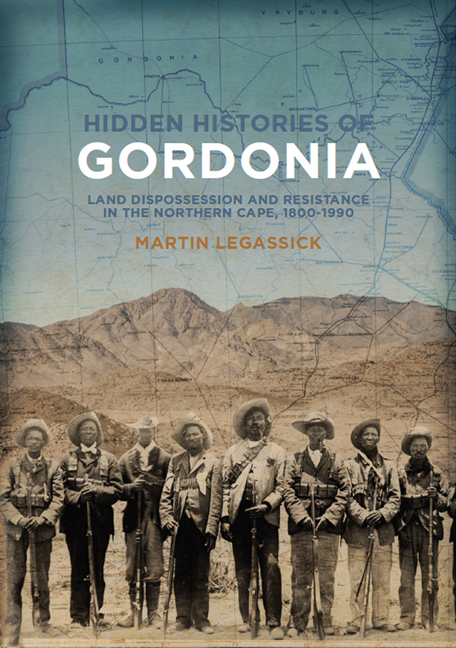Book contents
- Frontmatter
- Dedication
- Contents
- Acknowledgements
- Acronyms and abbreviations
- Illustrations
- Preface
- Chapter 1 The prehistory of Gordonia
- Chapter 2 The Baster settlement of Gordonia and its decline
- Chapter 3 The will of Abraham and Elizabeth September: a struggle for land in Gordonia, 1898–2014
- Chapter 4 From prisoners to exhibits: representations of Bushmen of the northern Cape, 1880–1900
- Chapter 5 South African human remains and the politics of repatriation: reconsidering the legacy of Rudolf Pöch
- Chapter 6 The early history of the brown Afrikaners in Riemvasmaak
- Chapter 7 The battle of Naroegas
- Chapter 8 The Marengo rebellion and Riemvasmaak, 1903–1907
- Chapter 9 The racial division of Gordonia, 1921–1930
- Chapter 10 Keidebees and Blikkies locations, Upington, 1894–1974
- Chapter 11 ‘All my powers have been swallowed by Upington’: the life and times of Alfred Gubula
- References
- Index
Chapter 6 - The early history of the brown Afrikaners in Riemvasmaak
Published online by Cambridge University Press: 20 April 2018
- Frontmatter
- Dedication
- Contents
- Acknowledgements
- Acronyms and abbreviations
- Illustrations
- Preface
- Chapter 1 The prehistory of Gordonia
- Chapter 2 The Baster settlement of Gordonia and its decline
- Chapter 3 The will of Abraham and Elizabeth September: a struggle for land in Gordonia, 1898–2014
- Chapter 4 From prisoners to exhibits: representations of Bushmen of the northern Cape, 1880–1900
- Chapter 5 South African human remains and the politics of repatriation: reconsidering the legacy of Rudolf Pöch
- Chapter 6 The early history of the brown Afrikaners in Riemvasmaak
- Chapter 7 The battle of Naroegas
- Chapter 8 The Marengo rebellion and Riemvasmaak, 1903–1907
- Chapter 9 The racial division of Gordonia, 1921–1930
- Chapter 10 Keidebees and Blikkies locations, Upington, 1894–1974
- Chapter 11 ‘All my powers have been swallowed by Upington’: the life and times of Alfred Gubula
- References
- Index
Summary
Riemvasmaak is an isolated, bare, and mountainous area north of the Orange River downstream from the Aughrabies Falls and bordering on Namibia, in the Gordonia district. It sprang to prominence in 1974 because of the forced removal of its inhabitants. The community, numbering about 1 000, was ethnically mixed and had intermarried for generations. Nevertheless some were moved, by the apartheid government, as ‘Damaras’, to Khorigas in the then South West Africa, others as ‘Xhosa’ to Welcomewood in the ex-Ciskei; others (‘coloureds’) settled elsewhere in the northern and western Cape. The land on which they had been living was handed over to the South African Defence Force. As the result of organisation by and pressure from Riemvasmakers, supported by the Surplus People Project (SPP), in 1995 the people returned to the land.
The area including Riemvasmaak is now split between Namibia and South Africa. But since before the declaration of the German Protectorate of South West Africa in 1885 it has had a certain unity to its history. Much of it, even as late as 1907 – and particularly that part which became Riemvasmaak – was an ‘open frontier zone’. It is part of the area along the Orange River occupied originally by Bushmen, by Nama and Kora, overlain by Oorlam, Griqua and Baster settlement in the late 18th and 19th centuries, and brought under British and German rule in the late 19th century. What has been known as the Riemvasmaak reserve comprises four farms surveyed in the early part of this century and known as Riemvastmaak, Wagenbrand, Bokseputs and Bokseputs Annex. Riemvastmaak, at least, was known as such before colonial annexation: it is important to keep in mind the difference between the names of the farms and the overall (later) name of the area.
Parts of this area have been researched, for different historical times, by historians of Namibia and South Africa, but without much cross-fertilisation. The boundaries established between the two countries have separated their histories. How these, and other, boundaries were established and how they were viewed at different times by those subjected to them is also a part of what I am concerned with in these essays, which concern the continuities in the history of resistance in this area to colonial penetration: Riemvasmaak is one important point of connection for historians of the two countries.
- Type
- Chapter
- Information
- Hidden Histories of GordoniaLand dispossession and resistance in the Northern Cape, 1800–1990, pp. 159 - 194Publisher: Wits University PressPrint publication year: 2016



